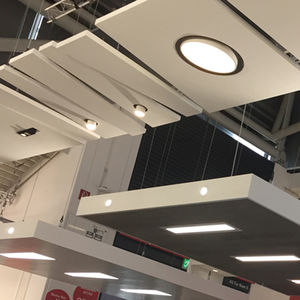
Fabric suspended ceiling CANOPYpanelacousticflame-retardant






Add to favorites
Compare this product
Characteristics
- Material
- fabric
- Type
- panel
- Technical characteristics
- acoustic, flame-retardant
- Aesthetics
- decorative
- Options
- light
- Thickness
40 mm
(1.575 in)
Description
The canopy system is created by hanging the products which provide fabric covered sound absorption which is used in the improvement of the interior acoustics horizontally with the connection apparatus by the ceiling surfaces. Decorative acoustic application is used to provide more effective acoustic improvement than the bonding technique to the existing ceiling surfaces and to hide the mechanical installation in the ceiling sections. It is especially preferred for minimizing noise in large-scale open office environments.
Our Canopy product range is your answer to your acoustic and aesthetic needs with its powerful sound absorption performance. In addition to reducing ambient noise, the architectural design can be hung horizontally on the ceilings to help you with your goals. Canopy provides a clean appearance with a balanced acoustic control. Available in various sizes, shapes and colors. Ideal for open office environments, lobbies, conference rooms, reception halls, museums to reduce echo and reflection. They all have a special suspension set.
Product Description
Core Material : 95 kg/m3 density acoustic glass wool.
Size : Can be produced in custom sizes.
Thickness : 40 mm
Edge Detail : Extra Strengthened.
Acoustic Performance : NRC değeri 0.95 -1.00aralığındadır.
Fire Resistance : Class A2 s1 d0 acoording to UNE-EN 13501-1:2007
Application : Suspended hangs free with ceiling set.
Catalogs
Catalogue 2019
54 Pages
*Prices are pre-tax. They exclude delivery charges and customs duties and do not include additional charges for installation or activation options. Prices are indicative only and may vary by country, with changes to the cost of raw materials and exchange rates.




